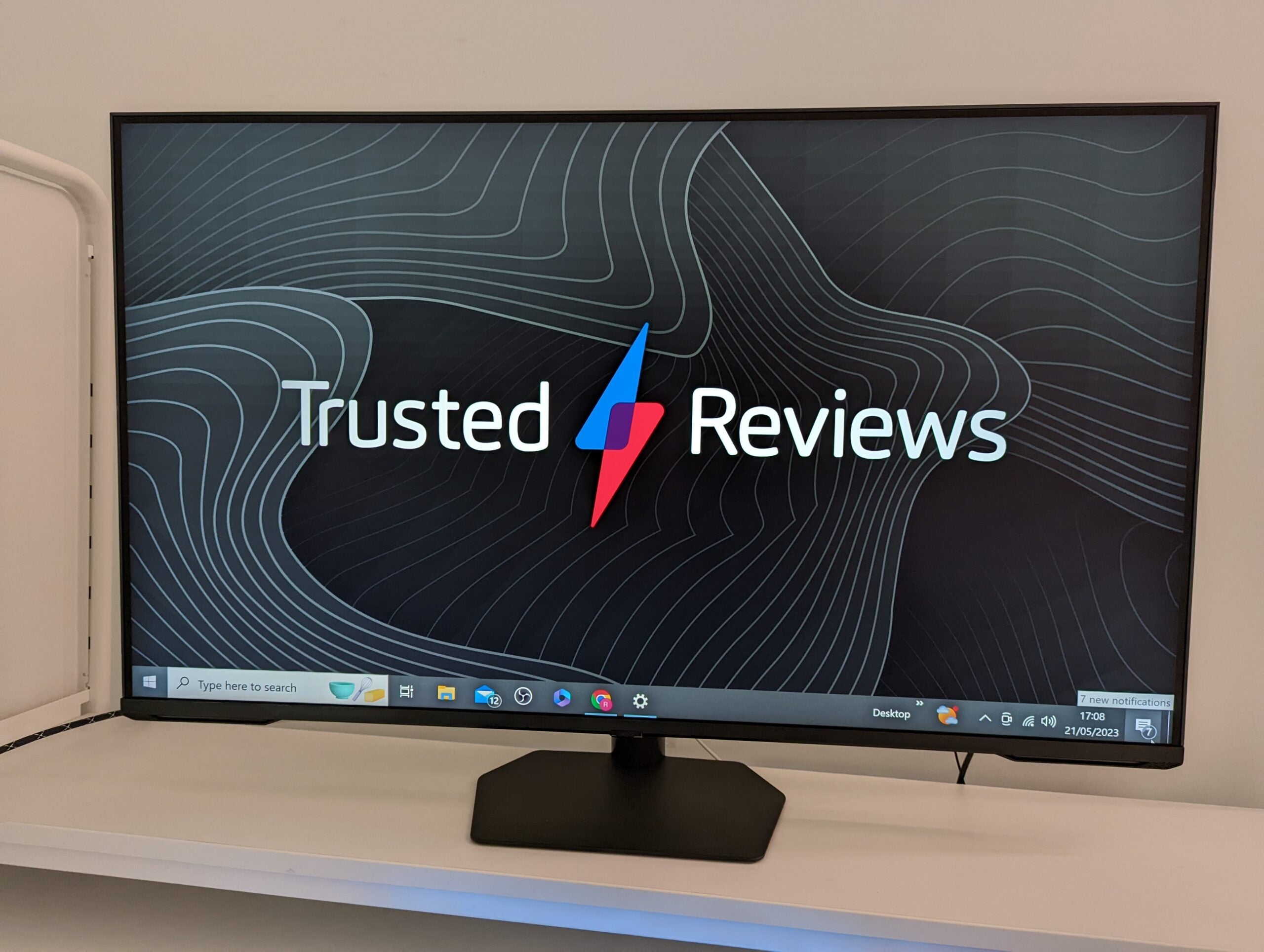Verdict
The Samsung Odyssey Neo G7 (2023) is a TV-sized gaming monitor with an outstanding picture thanks to the 4K Mini LED panel. The mediocre refresh rate may put off the eSports crowd but, otherwise, one of the best gaming monitors you can buy.
Pros
- Massive screen
- Sublime picture quality
- Bright enough for HDR
- Useful smart features
Cons
- Low refresh rate for the price
- Limited adjustability options
- Size will be difficult to accommodate for
Introduction
The Samsung Odyssey Neo G7 (2023) is a monstrously large gaming monitor, coming in at a whopping 43 inches diagonal, which is comfortably large enough to replace the TV in your living room.
Samsung isn’t just banking on sheer size however, opting for its own cutting-edge Quantum Mini LED panel to boost the picture quality, as well as adding in the smarts for integrated apps for both TV (Netflix, Disney Plus etc) and cloud gaming (Xbox Game Pass, GeForce Now and Amazon Luna).
It’s one of the very best gaming monitors I’ve ever tested, but it’s not without its issues. Here are my thoughts on the Samsung Odyssey Neo G7 (2023) after several weeks of use.
Design and features
- TV-sized 43-inch screen
- Features a flat panel instead of curved
- Poor adjustability options
Have I mentioned that the Samsung Odyssey Neo G7 is big? Because it is big, really big. Due to that massive 43-inch panel, I had to dismantle the top section of my desk to accommodate the monitor. I recommend checking your desk measurements before investing, as it’s possible you may have to do something similar.
You could even argue the large size of the Samsung Odyssey Neo G7 means it’s not suited to a desktop. When using it for office work, I found my neck having to do a lot more twists to view every corner of the display. Even for gaming, I found it better to sit at a distance with a gamepad rather than being hunched over a keyboard and mouse.
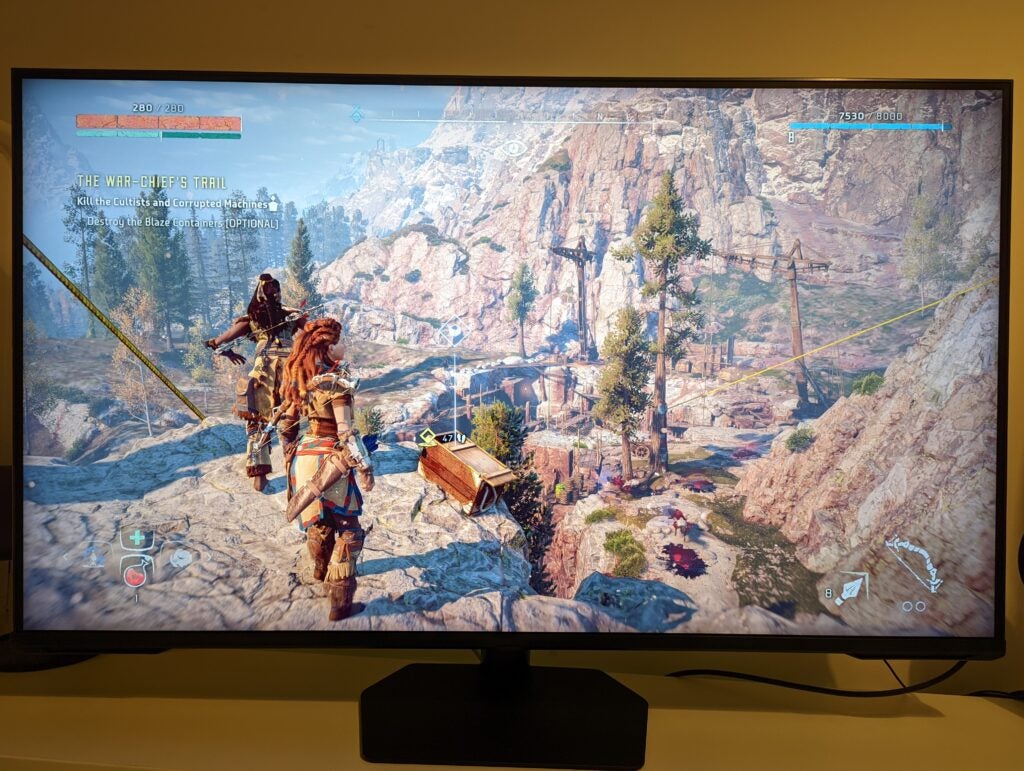
Instead, the Neo G7 could replace your TV in the living room, or even make a nice bedroom TV substitute if you fancy gaming from the comfort of your bed. The bright side of having such a large display is a more absorbing picture, making the mountainscape of Horizon Zero Dawn even more picturesque.
Samsung may have built a reputation for creating curved gaming screens, but the Neo G7 is completely flat. You don’t get as much immersion as you would with the upcoming Samsung Odyssey G9 OLED, which can fill your peripheral vision, but you also have to pay a lot more for the latter.
The Neo G7 has a thin black bezel bordering the screen, ensuring a stylish modern look. On the rear, Samsung has used glossy white plastic, which looks superb and gives the Samsung a sci-fi aesthetic.
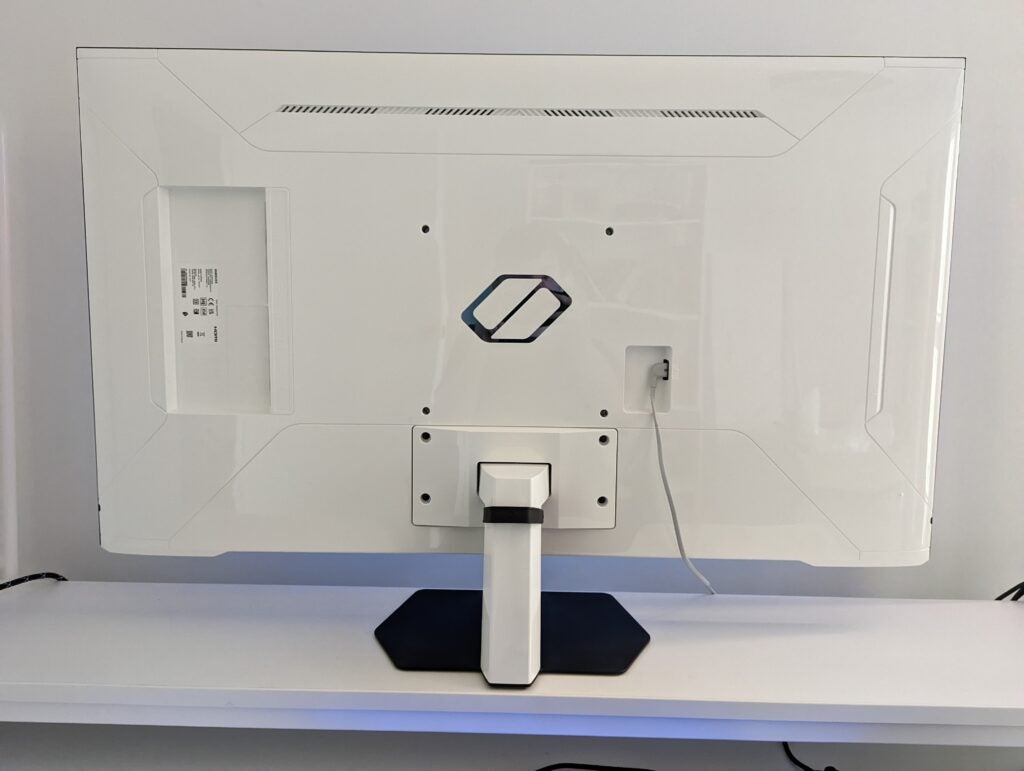
Samsung has bundled in a remote control (the same one you’ll find with the Samsung M8 monitor) into the Neo G7’s box. This not only allows you to tweak the volume and settings but makes it significantly easier to load up your favourite video streaming apps in an instant. It’s a far more user-friendly solution than reaching around the back of a monitor and blindly pressing buttons.
The remote uses USB-C to recharge, although you won’t need to top it up often, as I never needed to recharge the remote during my testing.
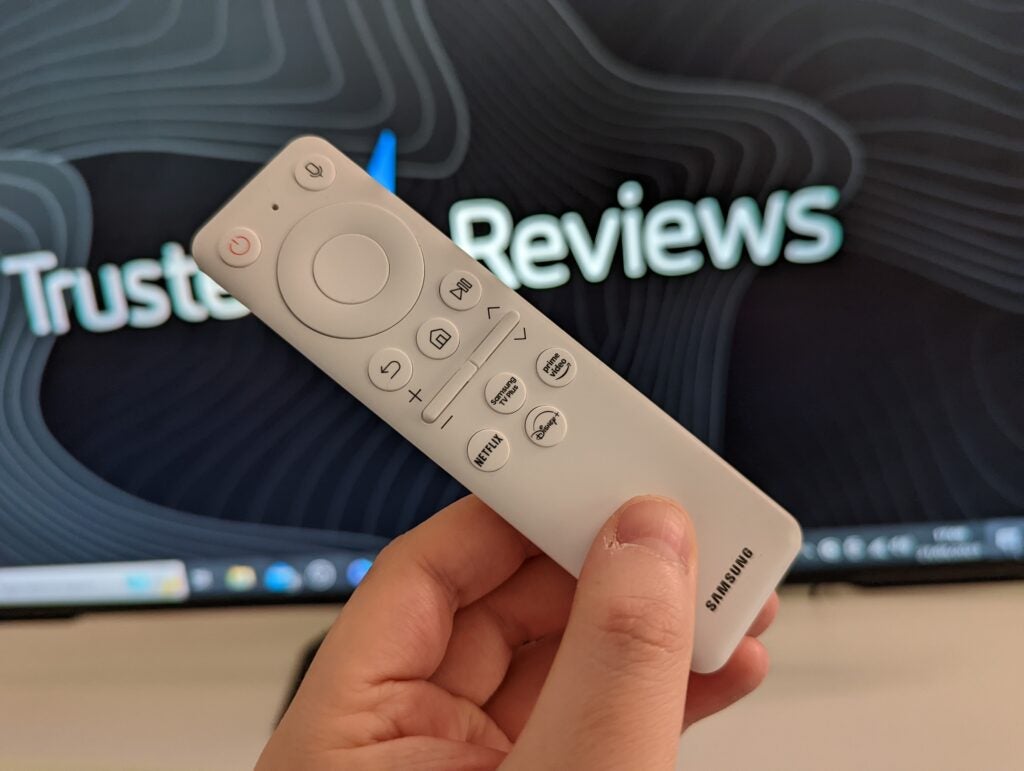
In what probably won’t come as a surprise, the Samsung Odyssey Neo G7 is one of the heaviest monitors I’ve ever used, hitting the scales at 9.2kg without the stand. I was still able to carry it to and from my desk with relative ease, but it’s certainly going to be a hassle if you ever move home.
Connecting the stand to the monitor is very easy, simply requiring you to tighten seven screws. The metal stand is sturdy with a large base anchoring the monitor down to prevent it from falling forwards or backwards.
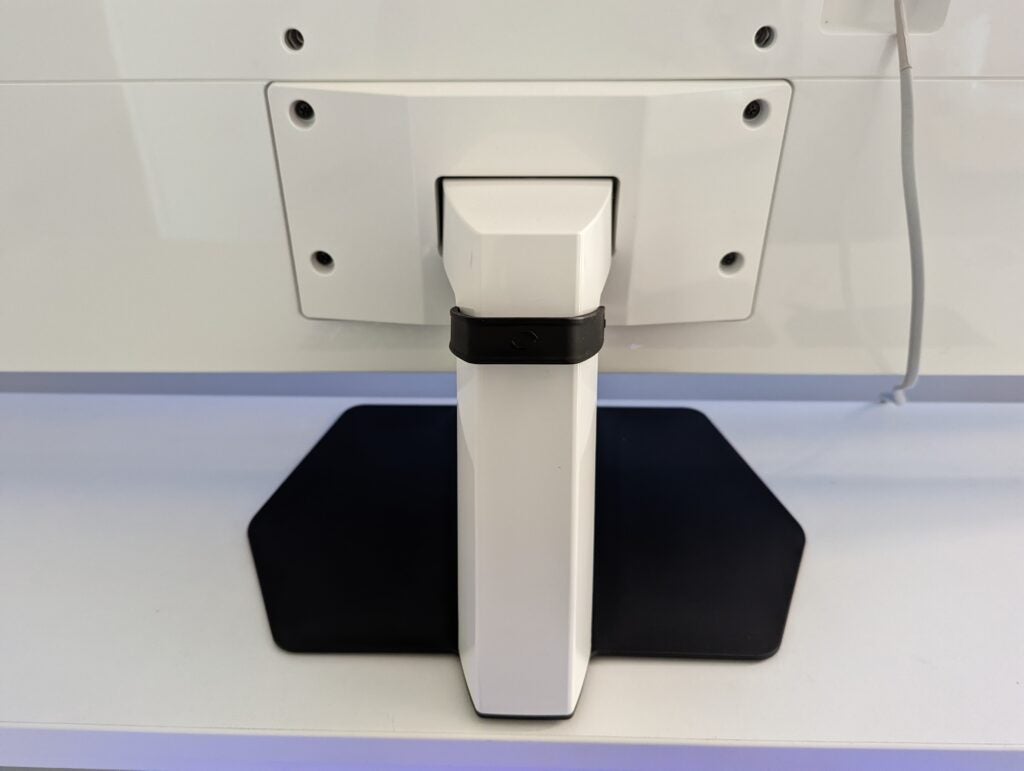
But this is likely the reason why there are so few adjustability options. You can tilt the screen upwards by 20 degrees, and downwards by 2 degrees, but that’s it. You can’t swivel or adjust the height of the monitor, once again questioning the merit of setting it up on a desk.
There’s a good selection of ports here including DisplayPort 1.4, HDMI 2.1 (with Arc support), USB 3.0, Ethernet and a headphone jack. A Wi-Fi 5 chip is also built into the monitor, allowing it to connect to the internet and run streaming apps without the need for a PC.
Samsung Odyssey Neo G7 ports
Samsung Odyssey Neo G7 ports
Samsung Odyssey Neo G7 ports
Samsung Odyssey Neo G7 power connection
Samsung has built speakers into the monitor, but you’re going to want to avoid using them, as they provide tinny audio quality that’s harsh on the ears. They also lack any satisfying oomph for Thanos’ skull-crushing punches during Avengers: Infinity War, and fail to offer any substantial bass for tracks like DeadMaus’ Professional Griefers, resulting in a weak and strained performance.
The gulf in audio quality was immediately clear when swapping between the monitor and my Razer Nommo speakers. When paying this much for a gaming monitor, you won’t want to settle for the substandard integrated speakers. Either invest in some speakers or don a pair of headphones.
Image quality
- Sharp 4K resolution
- Incredibly bright Mini LED panel
- Mediocre 144Hz refresh rate
The Samsung Odyssey Neo G7 (2023) packs enough pixels to support 4K (3840×2160) resolutions, resulting in pin-sharp pictures for both video and gaming content. The difference, compared to the standard Full HD, is immediately noticeable with more detail and clarity.
Samsung has also opted for Mini LED screen technology, instead of the OLED panel you’ll find on the new (and more expensive) Odyssey G9 (2023) gaming monitor.
Mini LED screens aren’t quite as skilled as OLEDs at presenting dark inky blacks, instead, appearing a little more grey as light seeps into the picture. But, Samsung has implemented its own Neo QLED ‘Quantum Mini LED’ technology, ensuring better light control to prevent any light from leaking to other parts of the images.
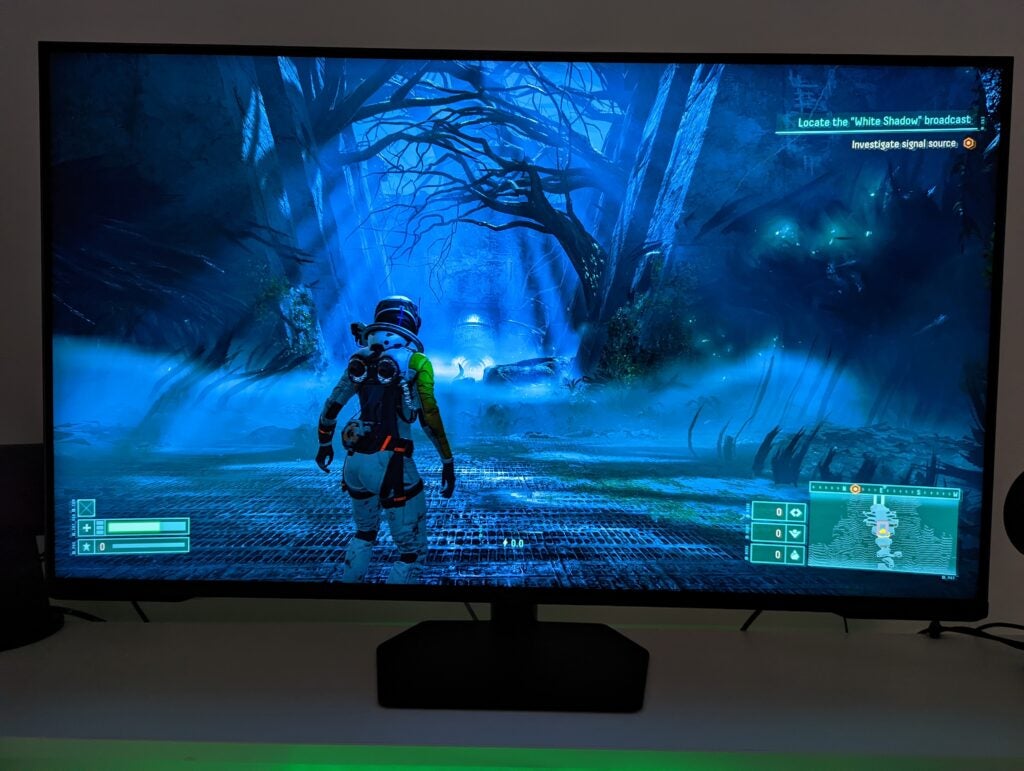
My own testing shows that Samsung has succeeded in this mission, with our colourimeter recording a 0.02-nit black level. That’s as close as you’re going to get to perfect 0 without using an OLED panel that can turn off the pixel completely.
The benefits of this were clear for dark scenes, such as the shadowy caves of Horizon Zero Dawn and the gloomy planets of Returnal, where the Neo G7 was able to display more detail than your average monitor.
Check out the comparisons between the G7 and my AOC Q3279VWFD8 monitor (which only cost me £166) below for displaying dark scenes – it’s an unfair comparison considering the huge price disparity, but it shows just how good the Samsung monitor is at displaying natural dark shades.
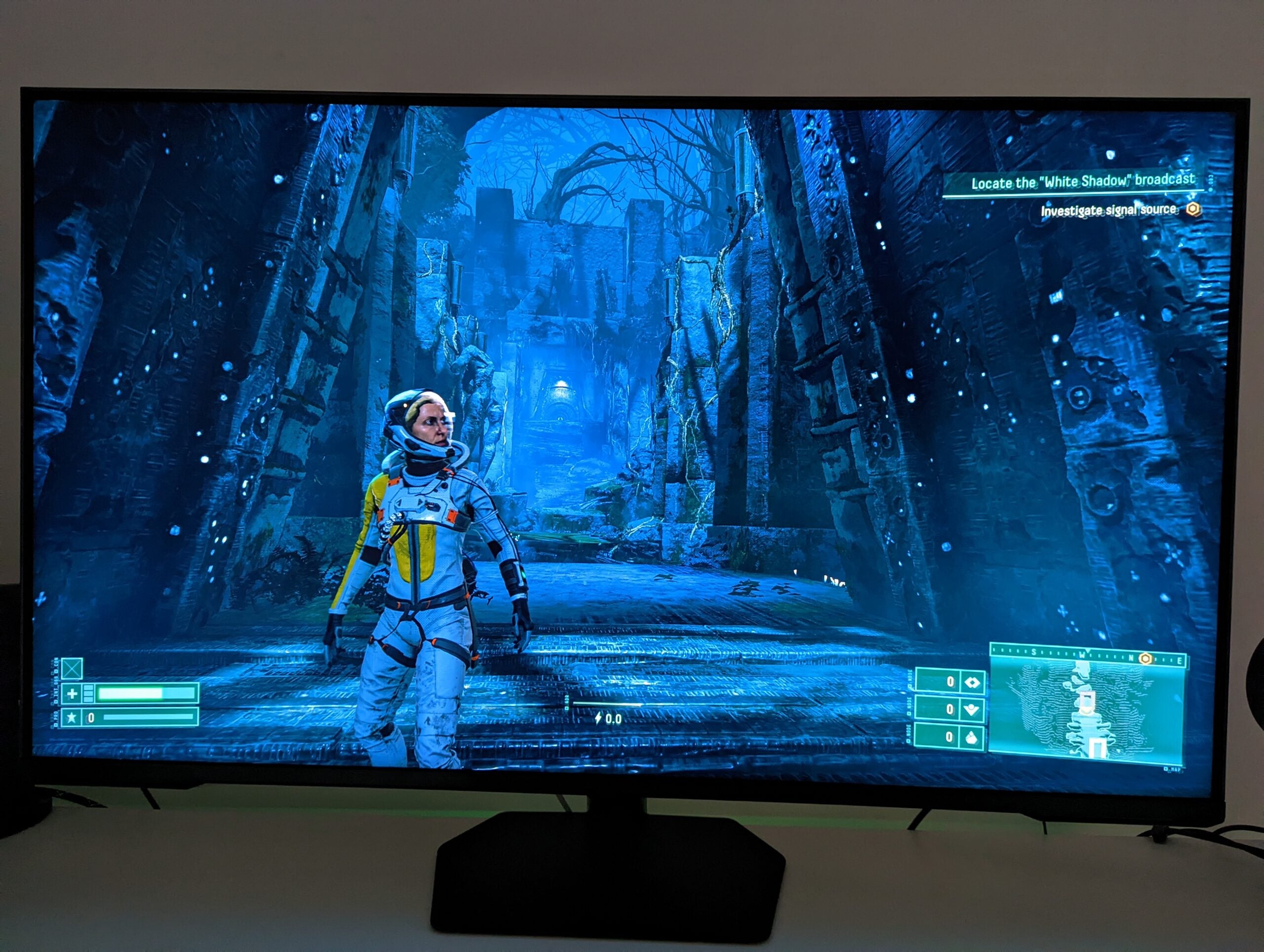
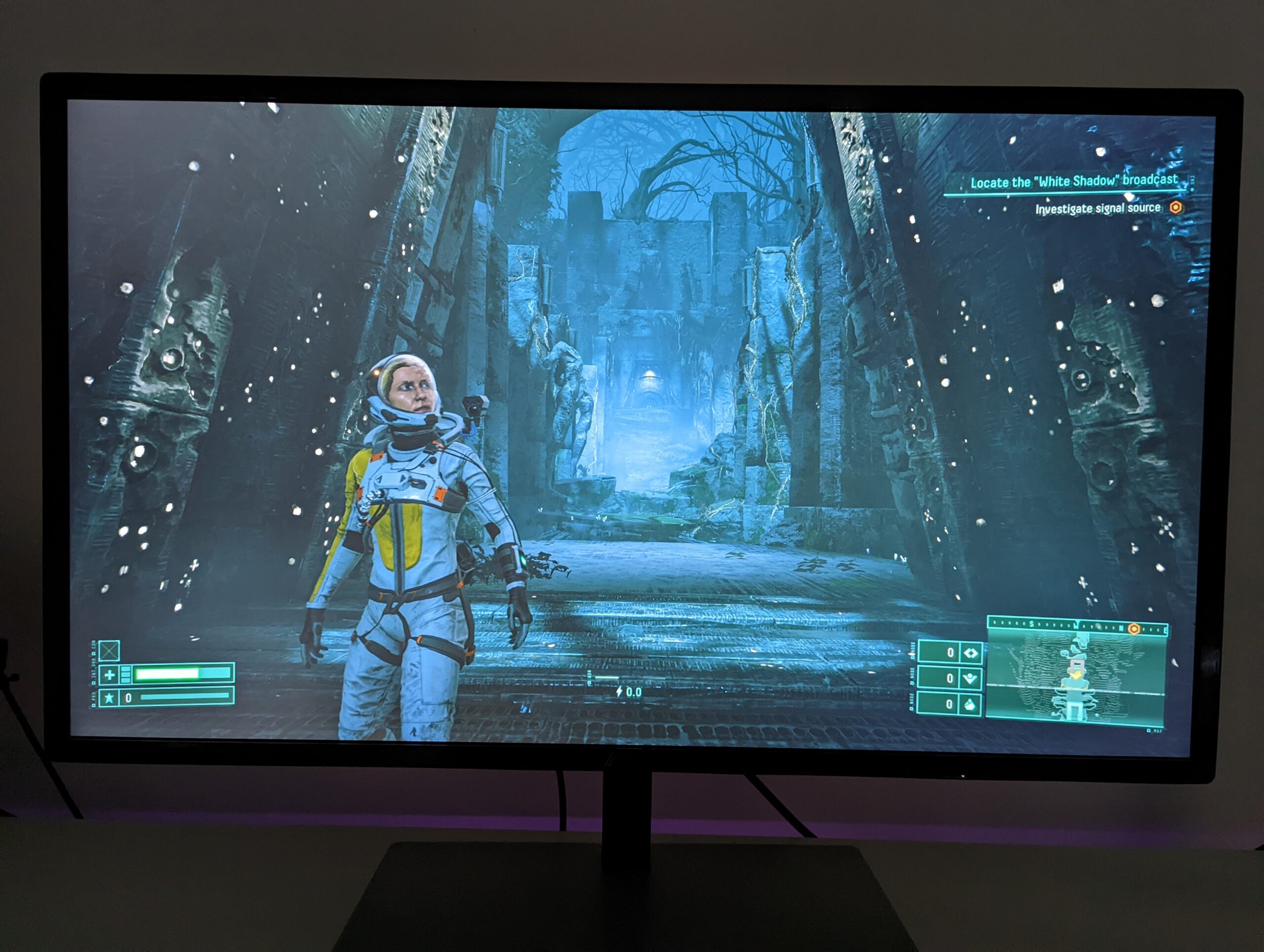
Thanks to the Mini LED display technology, Samsung has also been able to reach a high peak brightness of 490 nits for SDR content. This is significantly brighter than the claimed 250-nit figure of the Samsung Odyssey G9 (2023), which is restricted by its OLED panel.
That said, I’d recommend sticking to the out-of-the-box brightness settings of the Odyssey G7, as that gets you a better contrast figure of 5830:1 (compared to 3560:1 when maxing out the brightness). This is a superb result, helping bright objects stand out better from the dark. This was illustrated by the illumination of the fireflies in Returnal, beaming dazzling light that cut through the jet-black darkness.
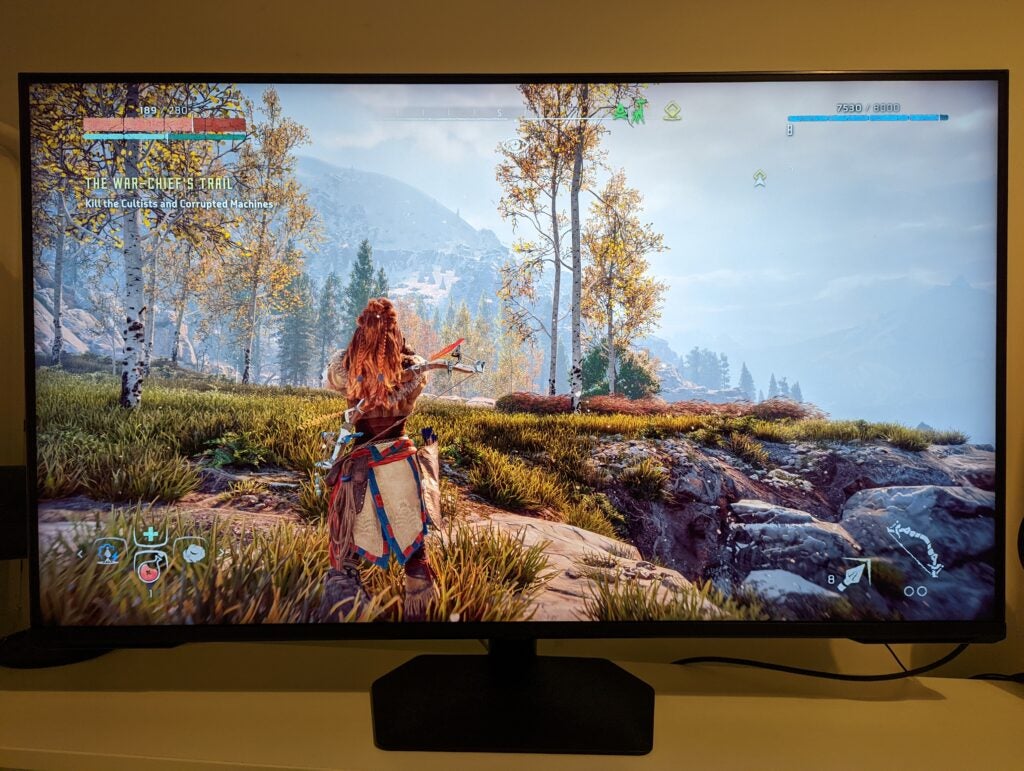
On-screen colours appear bold, bright and rich too. I was stunned by how good Horizon Zero Dawn looked on the Odyssey Neo G7, packing in enormous detail from the varying shades in the clouds to the vibrant autumnal leaves decorating the trees.
The high brightness and contrast offered by the Neo G7, as well as the 360 dimming zones, also allow for a strong HDR performance, with VESA Display HDR600 supported.
The colour coverage is impressive too, hitting 100% of the sRGB gamut, 91% of AdobeRGB and 98% of DCI P3. These figures mean the Odyssey Neo G7 is a perfectly good choice for professional creators who deal with colour-sensitive work such as photo/video editing.
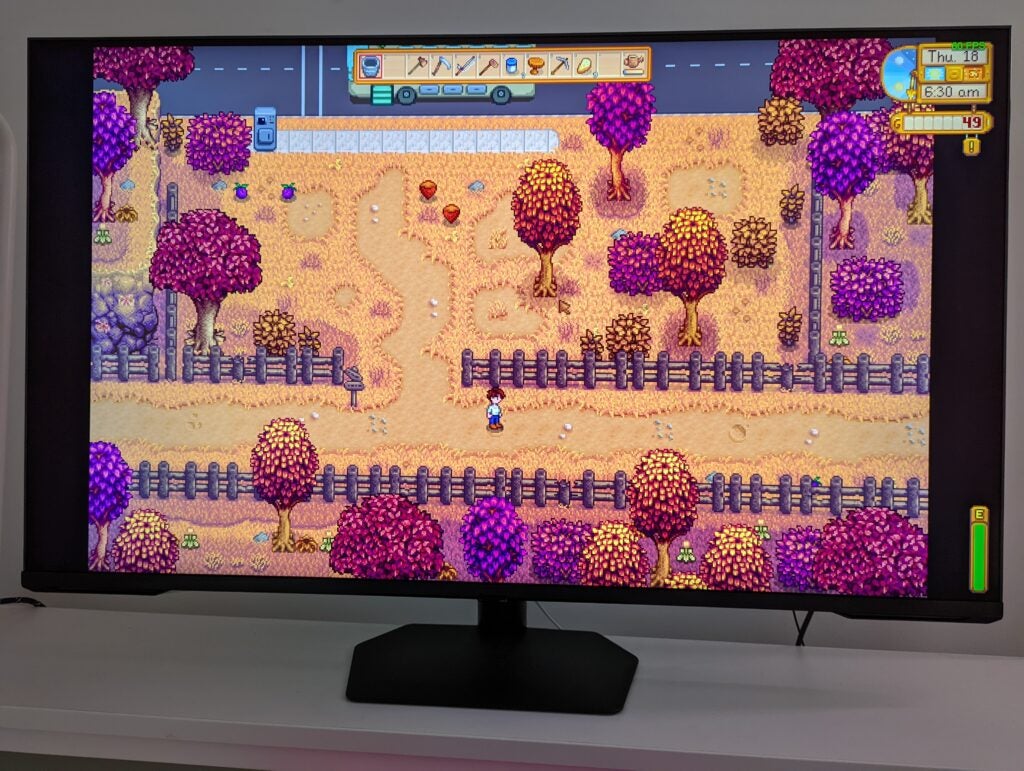
The Samsung Odyssey Neo G7 offers one of the best pictures I’ve seen from a gaming monitor. But, if you’re craving a top-notch eSports performance, you’ll be disappointed, as it only has a 144Hz refresh rate.
The Samsung Odyssey G9 OLED beats this figure comfortably with a 240Hz figure, while the likes of the Asus ROG Swift PG259QNR climb as high as 360Hz, although has a significantly smaller screen size. The average gamer will likely be content with the Neo G7’s 144Hz speed, but those who frequent online shooters may well want greater speeds at this price. The monitor does at least have a speedy 1ms (MPRT) response time, while AMD FreeSync Premium Pro will help to prevent screen tearing.
Software
- Can run streaming apps without external device
- Bundled remote makes it easy to tweak settings
- Bixby support for voice control
Unlike most gaming monitors, the Samsung Odyssey Neo G7 (2023) is able to connect to the internet and run streaming applications without the need to be connected to an external device such as a PC. That’s all thanks to the Tizen operating system that’s pre-installed onto the monitor.
I’m not sure this feature is going to be as useful as with the more productivity-centric Samsung M8 Smart Monitor, as you’ll need to plug the Neo G7 into a gaming PC to reap its full benefits anyway. But I suppose it may still be useful to boot up the likes of Netflix and Xbox Game Pass in a pinch without having to power on your PC.
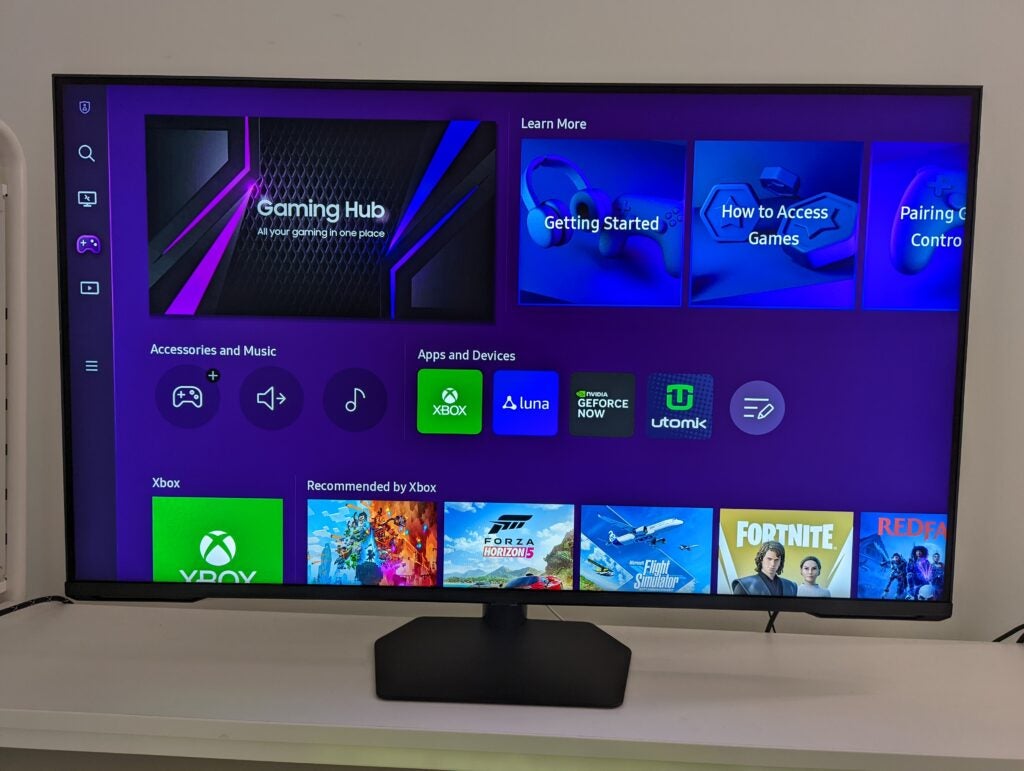
You can navigate the operating system with the bundled remote, which I found to be a far more seamless and user-friendly experience than prodding buttons or using a joystick built into the monitor’s body.
Tizen offers lots of features, from tweaking settings and selecting sources to loading up an entertainment app. Samsung TV Plus even lets you watch countless TV shows for free, which includes CNN, Bloomberg, Comedy Hub and more. I doubt many gamers will make use of this feature, but it’s still good to see the Odyssey Neo G7 providing the same level of smarts as Samsung’s productivity monitor line-up.
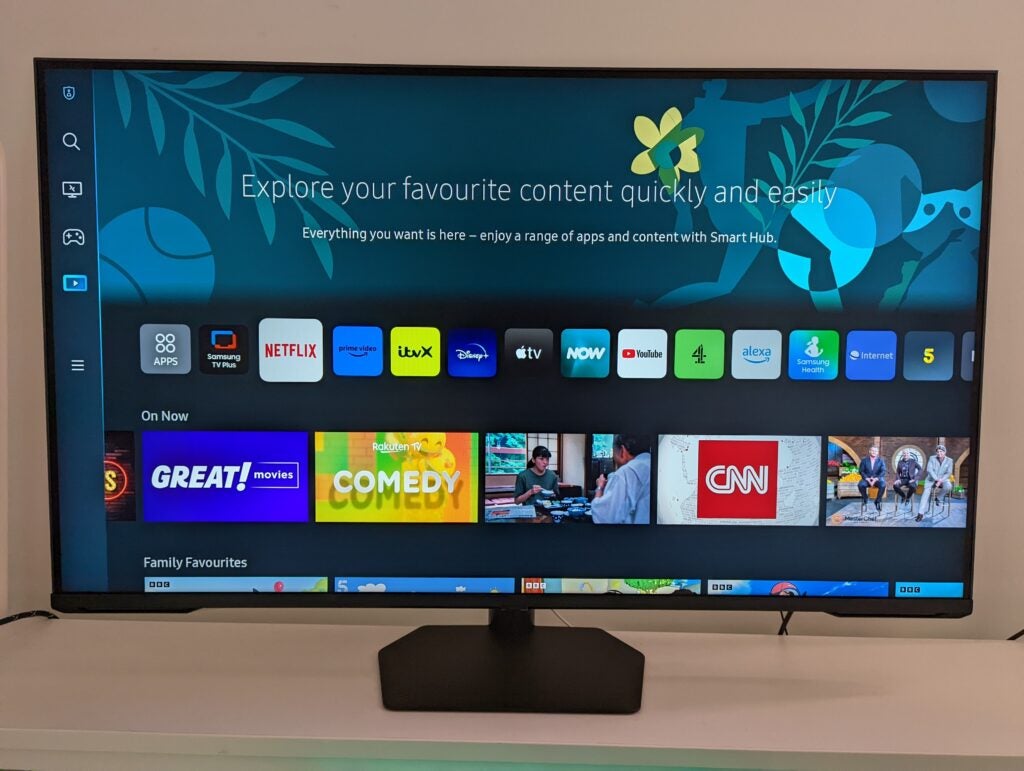
Bixby support is included, allowing you to hold down the button on a monitor and use voice commands to navigate Tizen. It works relatively well, but I personally preferred to stick to physical controls.
One aspect that will appeal to gamers is the Game Bar, which lets you check the status of settings such as FPS and HDR, while also tweaking the likes of aspect ratio, response time on the fly. You can even activate a virtual aim point to help improve your accuracy for first-person shooters.
Latest deals
Should you buy it?
You want a TV-sized gaming monitor with a dazzling display
The Odyssey Neo G7 (2023) has a 43-inch screen, which is large enough to replace your living room television. Picture quality is astounding too, with the Quantum Mini LED panel capable of a high contrast rate and superb colour coverage.
You want eSports-grade performance
The 144Hz refresh rate is a little on the low side for competitive gamers, while the large size of the screen makes it harder to spot on-screen motion in all corners of the display in the blink of an eye.
Final Thoughts
The Samsung Odyssey Neo G7 (2023) is a seriously impressive gaming monitor, although that humongous 43-inch screen side will be divisive. It will be too large to fit on most desks, and so may well suit being a TV replacement for your lounge or bedroom instead.
Picture quality is faultless though, with near-perfect black levels resulting in inky blacks, while the high brightness results in a superb contrast that can easily handle HDR competently. The low-ish refresh rate may put off eSport gamers though, while the limited adjustability options may make it difficult to accommodate.
With a launch price of just $799.99/£899, this is an absolute bargain for anyone who wants a super-sized screen with the best possible picture for single-player gaming. If you care more about size than speed, this is the best gaming monitor you can buy.
How we test
We use every monitor we test for at least a week. During that time, we’ll check it for ease of use and put it through its paces by using it for both everyday tasks and extended gaming sessions
We also check its colours and image quality with a colourimeter to test its coverage and the display’s quality.
FAQs
The inclusion of Neo in the name refers to the Mini LED back-lighting technology used with the monitor.
The Samsung Odyssey G7 Neo has a 43-inch screen.
Trusted Reviews test data
Verdict
The Samsung Odyssey Neo G7 (2023) is a TV-sized gaming monitor with an outstanding picture thanks to the 4K Mini LED panel. The mediocre refresh rate may put off the eSports crowd but, otherwise, one of the best gaming monitors you can buy.
Pros
- Massive screen
- Sublime picture quality
- Bright enough for HDR
- Useful smart features
Cons
- Low refresh rate for the price
- Limited adjustability options
- Size will be difficult to accommodate for
Introduction
The Samsung Odyssey Neo G7 (2023) is a monstrously large gaming monitor, coming in at a whopping 43 inches diagonal, which is comfortably large enough to replace the TV in your living room.
Samsung isn’t just banking on sheer size however, opting for its own cutting-edge Quantum Mini LED panel to boost the picture quality, as well as adding in the smarts for integrated apps for both TV (Netflix, Disney Plus etc) and cloud gaming (Xbox Game Pass, GeForce Now and Amazon Luna).
It’s one of the very best gaming monitors I’ve ever tested, but it’s not without its issues. Here are my thoughts on the Samsung Odyssey Neo G7 (2023) after several weeks of use.
Design and features
- TV-sized 43-inch screen
- Features a flat panel instead of curved
- Poor adjustability options
Have I mentioned that the Samsung Odyssey Neo G7 is big? Because it is big, really big. Due to that massive 43-inch panel, I had to dismantle the top section of my desk to accommodate the monitor. I recommend checking your desk measurements before investing, as it’s possible you may have to do something similar.
You could even argue the large size of the Samsung Odyssey Neo G7 means it’s not suited to a desktop. When using it for office work, I found my neck having to do a lot more twists to view every corner of the display. Even for gaming, I found it better to sit at a distance with a gamepad rather than being hunched over a keyboard and mouse.

Instead, the Neo G7 could replace your TV in the living room, or even make a nice bedroom TV substitute if you fancy gaming from the comfort of your bed. The bright side of having such a large display is a more absorbing picture, making the mountainscape of Horizon Zero Dawn even more picturesque.
Samsung may have built a reputation for creating curved gaming screens, but the Neo G7 is completely flat. You don’t get as much immersion as you would with the upcoming Samsung Odyssey G9 OLED, which can fill your peripheral vision, but you also have to pay a lot more for the latter.
The Neo G7 has a thin black bezel bordering the screen, ensuring a stylish modern look. On the rear, Samsung has used glossy white plastic, which looks superb and gives the Samsung a sci-fi aesthetic.

Samsung has bundled in a remote control (the same one you’ll find with the Samsung M8 monitor) into the Neo G7’s box. This not only allows you to tweak the volume and settings but makes it significantly easier to load up your favourite video streaming apps in an instant. It’s a far more user-friendly solution than reaching around the back of a monitor and blindly pressing buttons.
The remote uses USB-C to recharge, although you won’t need to top it up often, as I never needed to recharge the remote during my testing.

In what probably won’t come as a surprise, the Samsung Odyssey Neo G7 is one of the heaviest monitors I’ve ever used, hitting the scales at 9.2kg without the stand. I was still able to carry it to and from my desk with relative ease, but it’s certainly going to be a hassle if you ever move home.
Connecting the stand to the monitor is very easy, simply requiring you to tighten seven screws. The metal stand is sturdy with a large base anchoring the monitor down to prevent it from falling forwards or backwards.

But this is likely the reason why there are so few adjustability options. You can tilt the screen upwards by 20 degrees, and downwards by 2 degrees, but that’s it. You can’t swivel or adjust the height of the monitor, once again questioning the merit of setting it up on a desk.
There’s a good selection of ports here including DisplayPort 1.4, HDMI 2.1 (with Arc support), USB 3.0, Ethernet and a headphone jack. A Wi-Fi 5 chip is also built into the monitor, allowing it to connect to the internet and run streaming apps without the need for a PC.
Samsung Odyssey Neo G7 ports
Samsung Odyssey Neo G7 ports
Samsung Odyssey Neo G7 ports
Samsung Odyssey Neo G7 power connection
Samsung has built speakers into the monitor, but you’re going to want to avoid using them, as they provide tinny audio quality that’s harsh on the ears. They also lack any satisfying oomph for Thanos’ skull-crushing punches during Avengers: Infinity War, and fail to offer any substantial bass for tracks like DeadMaus’ Professional Griefers, resulting in a weak and strained performance.
The gulf in audio quality was immediately clear when swapping between the monitor and my Razer Nommo speakers. When paying this much for a gaming monitor, you won’t want to settle for the substandard integrated speakers. Either invest in some speakers or don a pair of headphones.
Image quality
- Sharp 4K resolution
- Incredibly bright Mini LED panel
- Mediocre 144Hz refresh rate
The Samsung Odyssey Neo G7 (2023) packs enough pixels to support 4K (3840×2160) resolutions, resulting in pin-sharp pictures for both video and gaming content. The difference, compared to the standard Full HD, is immediately noticeable with more detail and clarity.
Samsung has also opted for Mini LED screen technology, instead of the OLED panel you’ll find on the new (and more expensive) Odyssey G9 (2023) gaming monitor.
Mini LED screens aren’t quite as skilled as OLEDs at presenting dark inky blacks, instead, appearing a little more grey as light seeps into the picture. But, Samsung has implemented its own Neo QLED ‘Quantum Mini LED’ technology, ensuring better light control to prevent any light from leaking to other parts of the images.

My own testing shows that Samsung has succeeded in this mission, with our colourimeter recording a 0.02-nit black level. That’s as close as you’re going to get to perfect 0 without using an OLED panel that can turn off the pixel completely.
The benefits of this were clear for dark scenes, such as the shadowy caves of Horizon Zero Dawn and the gloomy planets of Returnal, where the Neo G7 was able to display more detail than your average monitor.
Check out the comparisons between the G7 and my AOC Q3279VWFD8 monitor (which only cost me £166) below for displaying dark scenes – it’s an unfair comparison considering the huge price disparity, but it shows just how good the Samsung monitor is at displaying natural dark shades.


Thanks to the Mini LED display technology, Samsung has also been able to reach a high peak brightness of 490 nits for SDR content. This is significantly brighter than the claimed 250-nit figure of the Samsung Odyssey G9 (2023), which is restricted by its OLED panel.
That said, I’d recommend sticking to the out-of-the-box brightness settings of the Odyssey G7, as that gets you a better contrast figure of 5830:1 (compared to 3560:1 when maxing out the brightness). This is a superb result, helping bright objects stand out better from the dark. This was illustrated by the illumination of the fireflies in Returnal, beaming dazzling light that cut through the jet-black darkness.

On-screen colours appear bold, bright and rich too. I was stunned by how good Horizon Zero Dawn looked on the Odyssey Neo G7, packing in enormous detail from the varying shades in the clouds to the vibrant autumnal leaves decorating the trees.
The high brightness and contrast offered by the Neo G7, as well as the 360 dimming zones, also allow for a strong HDR performance, with VESA Display HDR600 supported.
The colour coverage is impressive too, hitting 100% of the sRGB gamut, 91% of AdobeRGB and 98% of DCI P3. These figures mean the Odyssey Neo G7 is a perfectly good choice for professional creators who deal with colour-sensitive work such as photo/video editing.

The Samsung Odyssey Neo G7 offers one of the best pictures I’ve seen from a gaming monitor. But, if you’re craving a top-notch eSports performance, you’ll be disappointed, as it only has a 144Hz refresh rate.
The Samsung Odyssey G9 OLED beats this figure comfortably with a 240Hz figure, while the likes of the Asus ROG Swift PG259QNR climb as high as 360Hz, although has a significantly smaller screen size. The average gamer will likely be content with the Neo G7’s 144Hz speed, but those who frequent online shooters may well want greater speeds at this price. The monitor does at least have a speedy 1ms (MPRT) response time, while AMD FreeSync Premium Pro will help to prevent screen tearing.
Software
- Can run streaming apps without external device
- Bundled remote makes it easy to tweak settings
- Bixby support for voice control
Unlike most gaming monitors, the Samsung Odyssey Neo G7 (2023) is able to connect to the internet and run streaming applications without the need to be connected to an external device such as a PC. That’s all thanks to the Tizen operating system that’s pre-installed onto the monitor.
I’m not sure this feature is going to be as useful as with the more productivity-centric Samsung M8 Smart Monitor, as you’ll need to plug the Neo G7 into a gaming PC to reap its full benefits anyway. But I suppose it may still be useful to boot up the likes of Netflix and Xbox Game Pass in a pinch without having to power on your PC.

You can navigate the operating system with the bundled remote, which I found to be a far more seamless and user-friendly experience than prodding buttons or using a joystick built into the monitor’s body.
Tizen offers lots of features, from tweaking settings and selecting sources to loading up an entertainment app. Samsung TV Plus even lets you watch countless TV shows for free, which includes CNN, Bloomberg, Comedy Hub and more. I doubt many gamers will make use of this feature, but it’s still good to see the Odyssey Neo G7 providing the same level of smarts as Samsung’s productivity monitor line-up.

Bixby support is included, allowing you to hold down the button on a monitor and use voice commands to navigate Tizen. It works relatively well, but I personally preferred to stick to physical controls.
One aspect that will appeal to gamers is the Game Bar, which lets you check the status of settings such as FPS and HDR, while also tweaking the likes of aspect ratio, response time on the fly. You can even activate a virtual aim point to help improve your accuracy for first-person shooters.
Latest deals
Should you buy it?
You want a TV-sized gaming monitor with a dazzling display
The Odyssey Neo G7 (2023) has a 43-inch screen, which is large enough to replace your living room television. Picture quality is astounding too, with the Quantum Mini LED panel capable of a high contrast rate and superb colour coverage.
You want eSports-grade performance
The 144Hz refresh rate is a little on the low side for competitive gamers, while the large size of the screen makes it harder to spot on-screen motion in all corners of the display in the blink of an eye.
Final Thoughts
The Samsung Odyssey Neo G7 (2023) is a seriously impressive gaming monitor, although that humongous 43-inch screen side will be divisive. It will be too large to fit on most desks, and so may well suit being a TV replacement for your lounge or bedroom instead.
Picture quality is faultless though, with near-perfect black levels resulting in inky blacks, while the high brightness results in a superb contrast that can easily handle HDR competently. The low-ish refresh rate may put off eSport gamers though, while the limited adjustability options may make it difficult to accommodate.
With a launch price of just $799.99/£899, this is an absolute bargain for anyone who wants a super-sized screen with the best possible picture for single-player gaming. If you care more about size than speed, this is the best gaming monitor you can buy.
How we test
We use every monitor we test for at least a week. During that time, we’ll check it for ease of use and put it through its paces by using it for both everyday tasks and extended gaming sessions
We also check its colours and image quality with a colourimeter to test its coverage and the display’s quality.
FAQs
The inclusion of Neo in the name refers to the Mini LED back-lighting technology used with the monitor.
The Samsung Odyssey G7 Neo has a 43-inch screen.


















